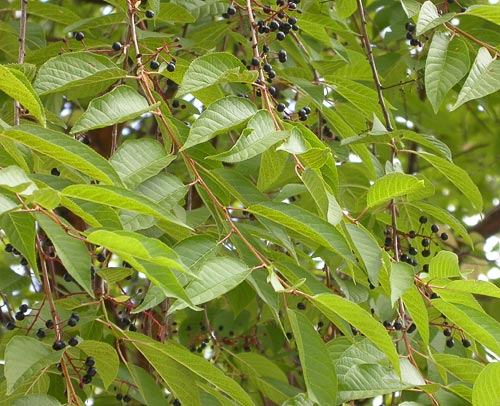Relatives
Padus maackii (Rupr.) Kom. - Amur chokecherry.
Taxonomic position.
Family Rosaceae Juss., genus Padus HillSynonyms.
Prunus maackii Rupr., Cerasus maackii (Rupr.) Eremin & SimaginMorphology and biology.
Tree, 15 (17) m tall. Stems are covered with peeling bark of brownish, golden or yellowish fulvous color, sometimes with orange hue. Branches are yellowish brown. Leaves are 5-13 cm long and 3-5 (6) cm wide, varying from elliptical to ovate-elliptical, oblong-cuspidate, with a rounded or heart-shaped base, sharply serrated along the edges with denticles terminating in seta; usually bright green above with a lighter color and numerous punctate glandules below, varying on both sides from bare to slightly pubescent (mostly along the veins). Petioles are 5-25 mm long, pubescent, without glandules. Flowers emerge in groups of 10-20 (30) in compact racemes 4-5 cm long, settled on pubescent pedicels. Sepals are acute, glandular-dentate. Hypanthia are ovate-elliptical, pubescent. Corollas are white, 7-10 mm in diameter. Stamina are longer than petals. Fruits are 3-5 mm in diameter, black, with highly stainable, dark violet juice, bitter-flavored but readily consumed by many bird species. Kernels are ovoid, slightly wrinkled. Entomophilous. Ornito- and zoochore. Propagated by seeds and softwood cuttings. Seeds should be stored for 3-4 months at 3-5╓C. Blossoms in May; bears fruit in late August. 2n = 32.Distribution.
Distributed throughout the Russian Far East, Northeastern China, and Korea.Ecology.
Mesophyte. Photophilous. Gas-resistant. Grows in small groups or individually in dark coniferous or mountainous coniferous-broadleaved forests, as well as along rivulets and brooks. Grows at elevations as high as 700-800 m above sea level.Utilization and economic value.
Melliferous, industrial, ornamental. Has long been successfully utilized in park landscaping, distinguished for rapid growth. When used in crosses with cherry I.V. Michurin, cerapadus hybrids with quite edible fruits were obtained. Cerapadus forms are promising for hybridization aimed at breeding new high-yielding and cold-resistant varieties.References:
Brezhnev, D.D., Korovina, O.N. 1981. Wild relatives of cultivated plants in the flora of the USSR. Leningrad: Kolos, p. 235. (in Russian).Kharkevich S.S., ed. 1996. Vascular plants of the Soviet Far East. Vol. 8. Leningrad: Nauka, pp. 237-238. (in Russian).
Koropachinskiy I.Yu., Vstovskaya T.N. 2002. Woody plants of the Asian part of Russia. Novosibirsk: Publishing House of SB RAS, Branch Geo, pp. 336-338 (in Russian).


